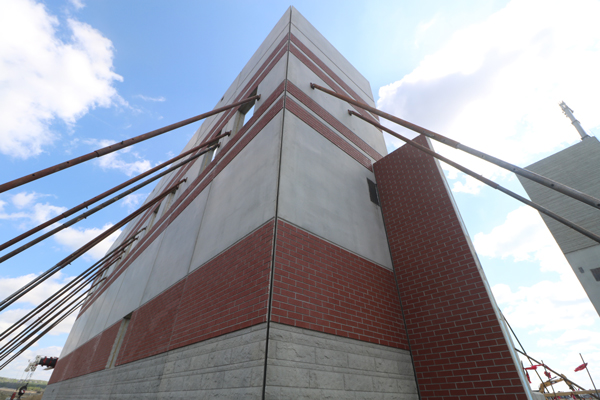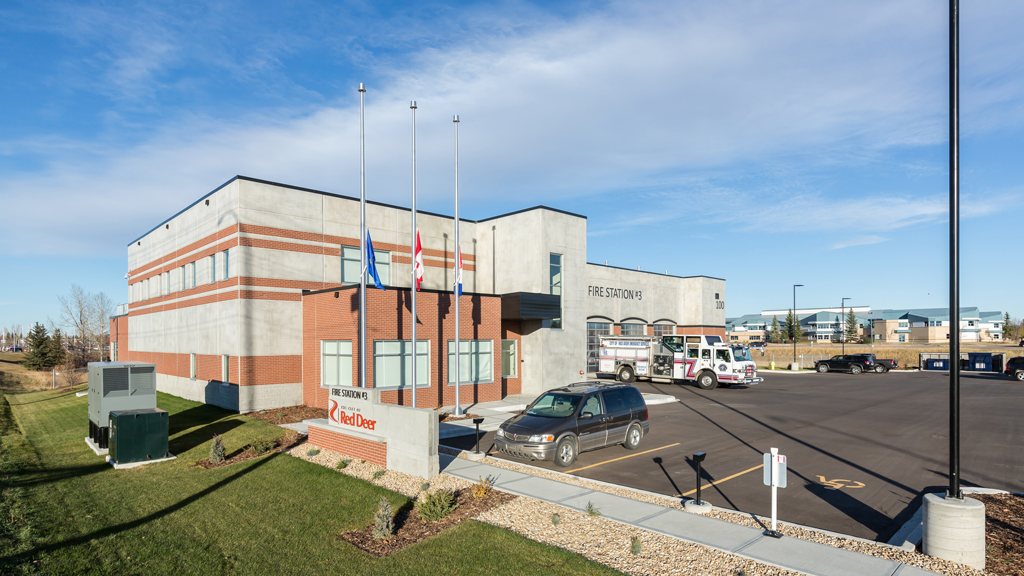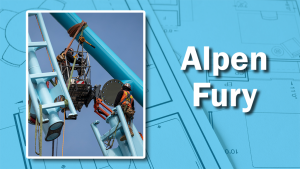Fire Halls 3 and 4 in Red Deer, Alta. were recently recognized by the Canadian Precast Prestressed Concrete Institute (CPCI) for their efficiency, resiliency and safety, using precast concrete as a structural material.
Both fire stations, which were designed and constructed by the same integrated project design (IPD) group, were named project of the month for May 2020.
IPD team members were the City of Red Deer (owner); Group2 Architecture Interior Design Ltd. (architect); Grubb Engineering Corporation (engineer); Chandos Construction (contractor); and Eagle Builders LP (precast supplier).
“What makes the fire halls worthy of note is that they were designed to be siblings, not twins,” said Craig Webber, principal of Group2 Architecture.
Fire Hall 4 is a 112,000-square-foot structure with five equipment bays.
It has training facilities for high-angled and confined space rescues and a hose tower to train firefighters how to use sprinklers and ladders.
Fire Hall 3 was built on a new site that used to be a stormwater detention pond.
“To build the foundation for the fire station, four metres of fill had to be added,” said Webber. “Precast concrete enabled us to be creative in filling the site.”
The designs of both fire halls, including the architectural finishes, precast concrete manufacturing and installation time, were similar, said Webber.
The precast concrete wall panels were designed to combine the structural, insulating and architectural elements in one building component.
“The fire halls have durable finishes on the inside, which is an important feature because the buildings are full of moisture,” said Webber. “After every time the trucks go out on a call, they get washed down. The trucks are very expensive and have to be kept dry.”
Thanks to the use of precast concrete, both fire station projects finished ahead of schedule and under budget.
“We learned from the construction of Fire Hall 4, which we built first, and then applied those lessons to 3,” said Webber.

It has training facilities for high-angled and confined space rescues and a hose tower to train firefighters how to use sprinklers and ladders.
Eagle Builders manufactured, supplied and installed the full structural package on both fire halls – walls, roof and mezzanine.
“The project capitalized on using architectural formliner and clay brick veneers cast into the concrete panels,” said Jesse Hawiuk, Eagle Builders business development manager. “In that way a single building product combined all of the architectural, insulating and structural components.”
Hawiuk said there are advantages to using concrete panels as structural building materials on fire halls.
“Concrete panels are non-combustible, they can speed up construction by 60 per cent, they have a longer lifespan than conventional systems and they require very little maintenance over their service life,” he said. “They are also very energy efficient and their thermal mass helps keep temperatures constant throughout the day.”
Grubb Engineering acted as plant engineers for Eagle Builders, designing most of the building’s shell and roof.
“Constructing the precast concrete panels in the shop was time consuming,” said Andy Smith, Grubb Engineering associate structural engineer. “But the results were certainly worth it.”
Brian Hall, CPCI managing director, said the institute has been naming 12 Projects of the Month (POM) every year since the initiative began in 2000.
The POMs are selected by a committee of CPCI management from the applications the organization receives.
“Only projects that are certified by the Canadian Precast Concrete Quality Assurance Program can qualify for a Project of the Month,” said Hall.
He said many CPCI members vie for the honour of being recognized as POM.
The Union Pearson Express, a rapid transit line that connects the Georgetown GO Transit line with Toronto Pearson International Airport, was named the June 2020 POM.
The 25-kilometre express rail service connects Union Station, in downtown Toronto, and Pearson International Airport, Canada’s two busiest transportation terminals.
To accelerate the construction schedule, the consortium that built the project used a number of precast concrete products.
For example, precast concrete pier sections avoided having to deal with cast-in-place concrete and facilitated construction during inclement weather, all the while maintaining quality.
The March 2020 POM was a new bridge at McGillivray Creek on Highway 11 in northern Ontario.
The Ontario Ministry of Transportation wanted a bridge that would minimize traffic disruption and reduce construction time.
The resulting design was a precast pre-stressed concrete girder bridge with an integral deck cast on top.











Recent Comments
comments for this post are closed